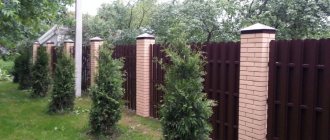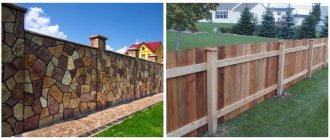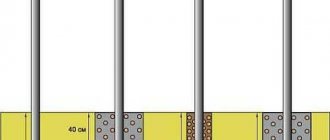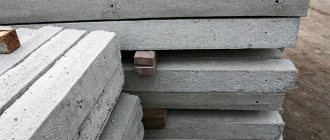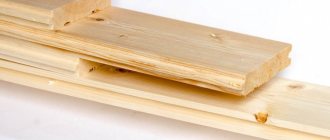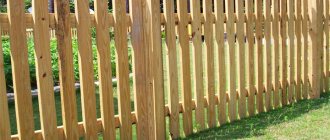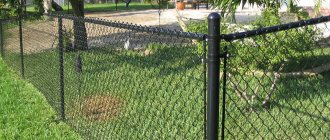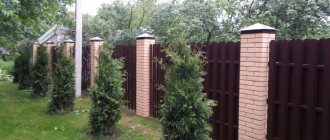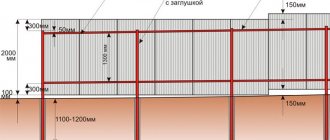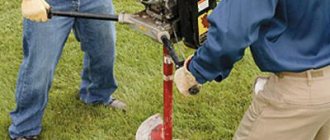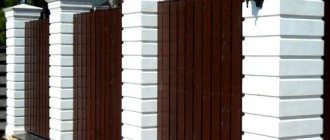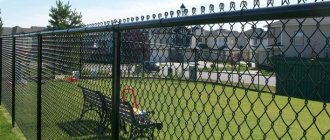Criterias of choice
Factors on which the choice of material and pole design depends:
- Purpose. Various solutions are being developed for options when it is necessary to build an economical fence between neighboring areas, a respectable fence as part of the entrance group, or a decorative fence to mark the boundaries of zones.
- Type of section filling. The load on the pillars varies significantly, whether it is a light, breathable picket fence, solid corrugated board or heavy brick.
- Required fence height. It is selected based on the recommendations of urban planning norms or SNT rules. In most cases, it is limited to 1.5-2.2 m.
- Soil type. Sandy, rocky or waterlogged soils require different approaches.
- Possibility of DIY installation. Not all types of poles are suitable for self-installation. In particular, driven piles are mounted only with a special pile-driving mechanism.
The calculation is carried out based on the wind load, type of filling and bearing capacity of the soil. In accordance with the tasks set and the results obtained, the issue of the design of the pillar and the material for its manufacture is decided.
Pipes for fence posts - rules for selection and installation
Brickwork, reinforced concrete pillars, asbestos-cement and iron pipes can be used as supports in the construction of a fence. Metal products are the most popular in the construction of lightweight fencing. Fence pipes perfectly withstand loads from metal mesh, corrugated sheets, slate, various types of picket fences, and other facing materials.
All such products differ in their parameters, based on which you can select suitable iron supports for a specific type of fence.
Profile pipes for poles - ready for installation
Calculation based on wind loads
Wind is the main load that fence posts carry. The calculation is carried out only for blind fences, taking into account several parameters:
- wind speed;
- air density;
- fence height;
- correction and aerodynamic coefficients.
With a span length of 2.5 to 3 m and standard wind loads, a profile of 60x60-80x80 mm or a round pipe of the same area with a wall thickness of 2-3 mm is sufficient for a fence made of corrugated sheets.
Overall dimensions of pipes
We list the main dimensions of metal pipes used for the manufacture of fences:
- Pipe wall thickness. It can be in the range of 1-12 mm. In our case, it is necessary to ensure that the walls have a thickness of at least 2 mm. Metal picket fence dimensions? It is better to choose a thickness of 4-5 mm.
- Section diameter. This parameter directly affects the stability of the supports. The larger the cross-sectional diameter, the more securely the stand will stand in the ground. However, pillars that are too thick should not be used either. Firstly, their installation will be fraught with significant difficulties, and secondly, under their own weight, such supports may become distorted. The diameter of 100x100 mm is the maximum permissible for the manufacture of fencing. The optimal diameter for the main supports is considered to be 57 mm for a round section, 60x60 mm for a square, and 40x60 mm for rectangular supports.
Pipes with a diameter of 60x60 mm or thinner ones can be used as intermediate supports. For example, 50x50, 50x40, 40x40 mm.
- Length. The standard lengths of iron pieces are 1, 5, 3 and 6 m. Of course, they can be cut into pieces of the length you need. If you purchased pipes of, say, 1.5 m, and this length is too short, the products can easily be extended by welding. Size of chain link fence posts? The final length of the pipe for the fence is selected to be 50-70 cm longer than the planned height of its installation. This is based on the fact that the iron support will go into the ground to such a depth. On sandy and loose soils, installing a pipe may require deeper burial, up to 1 m or even more.
How to choose depth
Factors influencing the depth of the pillar:
- own weight - the higher it is, the deeper the pit digs;
- properties and mechanical composition of the soil, groundwater level in the area;
- relief - supports require reinforcement for large differences in height;
- close location of bodies of water - during floods the fence may be flooded;
- weight and design of the fillings - some sections increase windage and create additional load;
- installation step - the load increases with its increase.
Effect of frost heaving on fence posts How deep should fence posts be buried? At first it may seem that the greater the foundation, the stronger the post will hold. Many sources recommend installing supports below the freezing point of the soil. But with small loads, this leads to an unreasonable increase in cost due to excessive consumption of material and physical resources.
Table of soil freezing by region
The optimal pinching size for a support at a standard height and average wind load is considered to be 70-120 cm. When the pillar is laid to this depth, the required strength is fully ensured.
Depth of concreting pillars for a mesh fence
The forces of frost heaving that occur in clayey and water-logged soils are reduced by filling the bottom of the pit with drainage materials - coarse sand, gravel, crushed stone. In some cases, strengthening the base of the pillar and drainage system are effective.
Depth of wooden fence posts
Which pipe to make a fence from: basic parameters
Each metal base has its own set of specific characteristics to make it suitable, sometimes unsuitable, for use on a particular object. When choosing, you need to consider the following parameters:
- Material. What kind of steel forms the structure plays an important role. Galvanized steel is the most reliable, also expensive option. Black steel is used less, but is financially acceptable. The products require annual painting and removal of rust at the base.
- Diameter. The stability of the structure is directly related to the cross-section diameter. Strong winds can cause a fence held together by thin posts to fall. With a height of about 2 meters, a square 80x80mm or a round 60mm is better. Minimum wall thickness 3mm.
- Height. Fences that are too high are sometimes called “sails”; they are the ones that have to hold back strong winds. When installing them, it is important to take into account the length, comparing it with the quality of the soil. Sometimes the soil is wet, loose, loose, and you have to increase the length to at least 15 cm. When it is not possible to independently determine the type of soil, you should contact a specialist.
Due to easier installation, metal pipes are more popular than other materials. Assuming to give the fence a serious load, they are the ones who are able to withstand the severity of the load being held and weather conditions. Among the obvious advantages of these structures, builders highlight the following:
Large types are installed only when using metal poles.
Can be used by manufacturers of frames for decorative purposes; the steel lends itself very well to painting. Metal supports are reused many times. The fence project will be cheaper; you can make the frame using used pipes.
Installation of metal poles
Depending on the design load, the supports are secured in various ways: by butting, driving into the ground, full or partial concreting. Combined installation can be used, for example, driving with butting or driving with partial concreting.
ways to install metal fence posts
Butting
A simple and reliable way to install metal supports that do not experience heavy loads. The fillings are made of chain-link mesh, picket fence and other breathable lightweight materials.
For butting the following are used:
- gravel;
- crushed stone;
- broken bricks or other building materials.
The work is carried out in the following sequence:
- In the places where the supports are installed, dig or drill holes 70-120 cm deep and 15-20 cm larger than the cross-section of the supports. When drilling, first turn the hand drill in one direction, then in the opposite direction, and remove a portion of the soil.
- Pour a layer of gravel and compact it with a crowbar.
- Install the stand and fix it strictly vertically.
- Fill the hole layer by layer with a mixture of gravel and sand, compacting each layer well and spilling with water.
- The installation site can be sprinkled with earth on top.
To ensure reliable adhesion of the particles to each other, it is recommended to impregnate the layers with a clay solution. It plays the role of a binder and gives the base solidity.
If there is a large amount of work to be done, you can rent a drill with a gasoline engine. With its help, well preparation will take very little time.
Hammering
This is an easy way to install metal fence posts without doing a lot of digging. But no less physical effort will be required. You will need a sledgehammer, with which the pipe is manually driven into the ground, a jackhammer or a special device - a “headstock”. It is attached to the top of a pole and delivers cyclic blows using a falling weight. It is recommended to weld a reinforcing pad to the end of the pipe.
The driving technology is as follows:
- Before installation, dig pits 30 cm deep at the points marked for the posts.
- Place the pole vertically, applying several gentle blows.
- Drive the post to the required depth, constantly monitoring the position.
- Fill the pit with crushed stone and sand and compact it.
The advantages of driving are economical consumption of materials, readiness for installing sections immediately after installation of the supports.
Concreting
This is a more complex, but reliable method for any soil and any load without restrictions. For concreting, M150-M200 mortar is used. One support will require no more than 30-40 liters of concrete.
Full concreting
This method is used when installing heavy brick or concrete pillars. The pit is filled with mortar to its entire depth, which ensures high load-bearing capacity of the support.
If the site has loose or dry sandy soil, it is recommended to use waterproofing made of roofing felt or dense film. The waterproof material is rolled into a tube and placed inside the well. This measure will help avoid rapid dehydration of concrete and a decrease in its strength.
The technology for completely concreting a fence support includes:
- Drilling a well or digging a pit to a depth of 0.7-1.2 m.
- Adding drainage materials - crushed stone, sand, gravel - with a tamper.
- Installation of formwork in the above-ground part. This is necessary to strengthen the weakest point - the area where the pillar emerges from the ground. For a tighter grip in this place, scraps of reinforcement or steel profile are welded to the post.
- Installing the pole and securing it in a vertical position. If there is no assistant, the pipe is fixed in pieces of brick, supports or other devices.
- Filling the pit with concrete. To release air bubbles, the mixture is compacted with a crowbar or reinforcement.
During the process of filling the well, the position of the support can be adjusted. To continue work, you need to wait until the mixture has completely hardened. Depending on weather conditions, this period is 5-10 days.
Partial concreting with a collar device
The method is similar to the previous one, but requires less cement consumption. There are 2 options for installing a post with partial concreting:
- The first method is used on non-heaving soils - sandy loam, sand. The well is drilled to 1/2-1/3 of the required immersion depth of the support. The post is mounted by hammering. The pit is filled with concrete, forming a “collar”. For reinforcement, cross members made of steel rods and profiles are welded into the concreted part.
- The second method is more labor-intensive, but allows you to avoid frost heaving on clay soils. The well is dug below the freezing point and filled with concrete to a depth of 0.7 m. Crushed stone is poured from above to ground level. It is recommended to weld reinforcement at the bottom of the column to ensure strong adhesion of the concrete to the support.
Which posts are suitable for corrugated board fencing?
Strictly speaking, any. However, we are interested in a material that is as durable and strong as possible. Wood is the least suitable option. Its service life is much shorter than that of metal.
Having installed corrugated sheeting on pine racks treated with an antiseptic, you will have to remove it after 6 years and start work again. Using larch or oak extends the life of the frame, but increases its cost. Therefore, wooden posts are most often used for temporary fencing.
You can eliminate the contact of wood with the ground by making a metal adapter and concrete it in the foundation. However, this option is not suitable for high fences experiencing intense wind loads. Another similar option is to use a piece of profile pipe as a steel sleeve into which the post is inserted and then concreted.
The next contender for the title of supporting structure is asbestos-cement pipes. They are inexpensive, do not rot and are quite durable. Their disadvantages include the fragility and complexity of fastening the purlins.
Asbestos-cement pipes should not be left open. Rainwater, falling into them like a well, will freeze in winter and tear the walls. Therefore, after installation, they are filled with cement mortar, or before work begins, plugs are placed at both ends.
Reinforced concrete is also suitable for making posts. The only requirement that needs to be taken into account at the pouring stage is the installation of metal embedded plates to which the purlins will be attached.
The technology of industrial concrete casting has made great strides in recent years. Therefore, instead of labor-intensive “home crafts”, we recommend buying aesthetic prefabricated structures.
Metal is the undisputed leader in the field of fence construction. It goes well with corrugated sheets, withstands wind loads well and retains its strength for 50 years. The only thing that is required from the owner is to update the anti-corrosion protection once every 3-4 years.
The cross-sectional shapes of standard steel posts are circle, square and rectangle. A profiled pipe is more convenient to install and for this reason it is used more often than a round one.
Fastening the purlins can be done in different ways using welding, additional elements and threaded connections. This is another advantage of steel racks.
Fence posts made from corrugated sheets are often made of brick. However, even in this case it will not be possible to do without metal. It is required for the manufacture of embedded parts to which the logs are fixed, and to give the structure sufficient rigidity.
The basis of brick columns is reinforcement bars or profile pipe. The space between the masonry and the metal is filled with mortar.
The disadvantages of brick racks include the high price, labor-intensive masonry and heavy weight, which requires pouring a solid foundation. In terms of aesthetics and durability, they are superior to other types of fence supports.
To install corrugated fencing, it is advantageous to use screw posts. These are hollow steel pipes of square or round profile, equipped with a wide blade.
Using them, you can assemble a strong frame without excavation and concrete. The stand-pile is screwed into the ground to a depth of 0.8-1.2 meters and is firmly held in it due to the wide blades. On soft soil, screw posts can be placed manually using a special mechanism for gripping and rotating.
